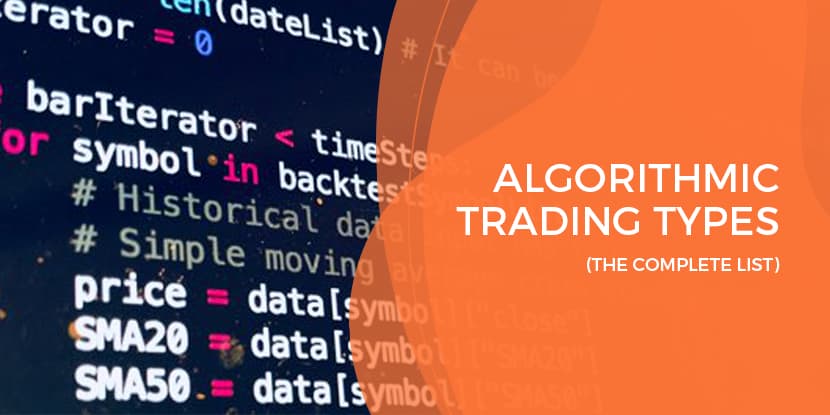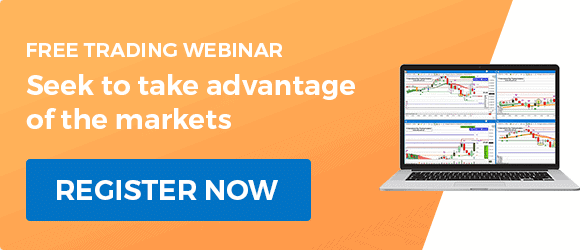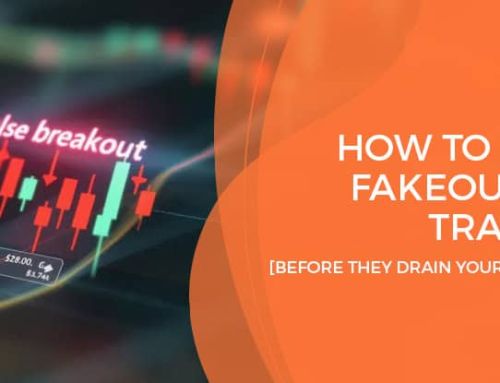Algorithmic trading types, or algo trading types, are a process of automatically executing orders through a computer program. In this article we will look at algorithmic trading types, and algo trading as a practise.
What is Algo Trading?
Algorithmic trading is the use of algorithms to make trading decisions. Algorithmic trading is used in both buy and sell orders. Algorithmic traders use algorithms to try to predict future prices, trends, and movements.
An algorithm will be written into a software program which executes trades via a trading platform. The program will have set rules for identifying high probability trades, as well as setting profit targets and providing trading risk management.
Algo Trading 101
Algorithmic trading is a defined set of instructions based on timing, price, quantity, or any mathematical model. The goal of algorithmic trading is to provide a way of identifying trades based on the same methods a human uses. But in doing this, an algorithm removes both human error and emotional interference.
A quick example of an algorithmic instruction could be to monitor a market or stock for a particular trading indicator. For example, “wait for the relative strength index to reach 35, then buy. Of course, there would be other metrics to also satisfy to avoid ‘no trade zones’.
The instruction to then sell might be “wait for the relative strength index to reach 65, then sell”. This would be a very basic algorithm for buying and selling an asset.
Algorithmic Trading Types
This is a comprehensive list of types of algorithmic trading. All trading algorithms need to identify trades with a high probability of being profitable. Here are a few trading strategies that trading algorithms might look to take advantage of.
Trend Trading
Trend trading algorithms are quite common because of their simplicity. The algorithm will track highs and lows in price movement and look for a trend in chart pattern either up or down.
The simplicity of these algorithms come from not needing to forecast or predict future price movement. The goal is to simply find trend lines of support and resistance without complicated calculations.
Trend trading algorithms may also use moving averages such as 50 and 200 day moving averages to identify trends forming.
Range Trading
In a similar way to trend trading, range trading will involve identifying a common support level and common resistance level. The strategy would be to buy off of support and sell off of resistance or vice versa.
In this instance the algorithm will look to identify common areas of price where the direction changes (a reversal). As with trend trading there is not advanced calculations for predicting future price.
Alternatively range trading may be used in the form of mean reversion. The idea is that highs and lows are temporary and that price always moves back to the mean price. Buying and selling is triggered based on the breaking of the defined price range.
Volume-weighted Average Price (VWAP)
The VWAP measures the average price of an asset for the day, this is based on volume and price. This strategy will look to break up large orders and release smaller portions based a volume profile. The strategy will attempt to execute as close to the VWAP as possible.
Time-weighted Average Price (TWAP)
The time-weighted average price strategy sends smaller orders to the market over time instead of all at once. The goal is to trade near the average price between start and end times, in order to limit market impact.
Relative Strength Index (RSI)
I mentioned this in the example earlier, it’s a rather simple idea. The relative strength index is a momentum indicator that shows how over-bought or over-sold an asset is. The indicator is an oscillator between 0 and 100. When the RSI reaches above 70 the asset is becoming over-bought. When the RSI drops below 30, it is becoming oversold. Price tends to correct its self by changing direction around these areas.
Implementation Shortfall
The implementation shortfall strategy is a way to save money on the cost of an order by trading off the real-time market. This means that the order is not executed right away, but instead is done at a later time when the opportunity cost is lower.
Does Algo Trading Work?
There is no one answer to this question as the efficacy of algorithmic trading will vary depending on the specific strategy being employed. Another factor would be the market conditions at the time. That being said, there is evidence to suggest that algorithmic trading can be effective in certain contexts, such as during times of market volatility.
Something to consider is how well an algorithm is programmed, and the risks of any bugs in the program. If you’re using an algorithmic trading robot you’re putting a lot of trust in a program to do its thing with your hard earned money.
Benefits of Algorithmic Trading
There are a number of benefits that can be gained from using an algorithmic trading strategy, including:
Drawbacks of Algorithmic Trading
So, it sounds like a bit of a no-brainer, right? Well… Algo trading isn’t quite that simple, and there are plenty of risks involved.
First of all creating an algorithmic trading program is an incredibly difficult thing to do, it requires advanced trading and programming knowledge. They’re also not easy to maintain and run without any errors.
It’s important to note that for each algorithmic trade there are many many other trades placed by both other programs and by humans. There is every possibility that price may gap or move in such a way that prevents the program from exiting the trade where it should, or even at all.
For human traders there is a system risk involved in trading. This can be a risk of computer or trading platform failure, or internet connection issues. The same thing occurs with algo trading, however the entire strategy is on auto pilot and reliant on all of these things.
Perhaps the biggest drawback for algo trading is that programs are almost always imperfect, think of how many times you update software for bug fixes. Essentially you are putting all of your trust in something thatt has the potential to fail entirely.
The more complex a program, or set of instruction in the algorithm the more points of failure exist. This means that the testing for such a program needs to be extensively back tested before it can be used.
If you are using an algo trading platform because you don’t have trading knowledge yourself, you need to be mindful of scams. People looking to make money in a realm they are not knowledgeable in is a goldmine for scammers. Unfortunately, there are many scams out there, be mindful and research before making any decisions.

Algorithmic Trading Types Bottom Line
Algorithmic trading can be a great way to trade securities. It can provide a number of benefits, such as liquidity, speed, and execution. However, there are also some drawbacks to be aware of.
If you don’t have the trading or programming skills it would be extremely risky to attempt to build and algo trading program. You would need to seek an existing algo trading service. If you’re looking to do this you should ensure that there is an independently audited proof of performance.
Although the thought of ‘trading on auto-pilot’ sounds tempting, we believe learning how to trade provides a skill that allows you to take the trading into your own hands.
A well trained trading brain can adapt to changing market conditions to make faster decisions. I would rather have disciplined discretion over my trading decisions than trust a robot over the long term. You have control of what you buy and sell, how you manage your own risk, as well as where, when, and how you trade. Essentially putting your trust in yourself, rather than someone else.
Weigh up the pros and cons for yourself and seek professional guidance from a financial planner if appropriate.
If you would like to learn more about day trading you can check out our next free trading class where we will show you how trading futures works and how to read candlestick charts.




